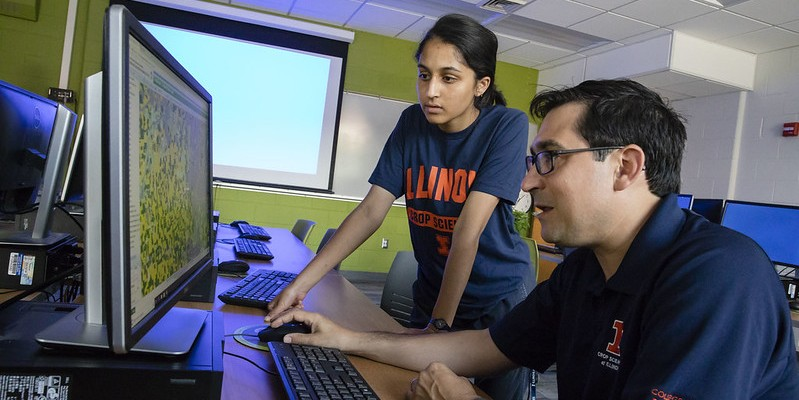Feb 21 2020
According to the predictions of certain reports, by 2027, the precision agriculture market will reach $12.9 billion. This leads to a growing demand to develop advanced data-analysis solutions that can support management decisions in real-time.
 Nicolas Martin (foreground) works with student to visualize digital field data. Image Credit: L. Brian Stauffer.
Nicolas Martin (foreground) works with student to visualize digital field data. Image Credit: L. Brian Stauffer.
New research by an interdisciplinary team of researchers at the University of Illinois provides a potential technique to accurately and efficiently process precision agriculture data.
We’re trying to change how people run agronomic research. Instead of establishing a small field plot, running statistics, and publishing the means, what we’re trying to do involves the farmer far more directly. We are running experiments with farmers’ machinery in their own fields. We can detect site-specific responses to different inputs. And we can see whether there’s a response in different parts of the field.
Nicolas Martin, Study Co-Author and Assistant Professor, Department of Crop Sciences, College of Agricultural, Consumer and Environmental Sciences, University of Illinois
Martin added, “We developed methodology using deep learning to generate yield predictions. It incorporates information from different topographic variables, soil electroconductivity, as well as nitrogen and seed rate treatments we applied throughout nine Midwestern corn fields.”
Martin and his colleagues worked with 2017 and 2018 data collected from the Data Intensive Farm Management project, which involved applying seeds and nitrogen fertilizer at different rates across 226 fields in the Midwest, Argentina, Brazil, and South Africa. The yield was predicted by pairing on-ground measurements with high-resolution satellite images from PlanetLab.
Fields were digitally disintegrated into squares of 5 m (roughly 16 feet). Data related to soil, seed rate, nitrogen application rate, and elevation were fed into the computer for each square, where the aim was to learn how the factors interact to predict yield in that specific square.
The team performed the analysis using a kind of artificial intelligence or machine learning called a convolutional neural network (CNN). Machine learning of certain types begin with patterns and instruct the computer to fit new data bits into those existing patterns.
Convolutional neural networks do not consider existing patterns. Rather, by taking bits of data, they learn the patterns organizing the data, analogous to how humans organize new information using neural networks in their brain. The CNN process that estimated the yield with high precision was also compared to other conventional statistical techniques and machine learning algorithms.
We don’t really know what is causing differences in yield responses to inputs across a field. Sometimes people have an idea that a certain spot should respond really strongly to nitrogen and it doesn’t, or vice versa. The CNN can pick up on hidden patterns that may be causing a response. And when we compared several methods, we found out that the CNN was working very well to explain yield variation.
Nicolas Martin, Study Co-Author and Assistant Professor, Department of Crop Sciences, College of Agricultural, Consumer and Environmental Sciences, University of Illinois
The use of artificial intelligence to decipher data obtained from precision agriculture is a comparatively new technique. However, according to Martin, his experiment just browses superficially with respect to the prospective applications of CNN.
Eventually, we could use it to come up with optimum recommendations for a given combination of inputs and site constraints.
Nicolas Martin, Study Co-Author and Assistant Professor, Department of Crop Sciences, College of Agricultural, Consumer and Environmental Sciences, University of Illinois
The article titled “Modeling yield response to crop management using convolutional neural networks” was published in Computers and Electronics in Agriculture. Alexandre Barbosa, Rodrigo Trevisan, Naira Hovakimyan, and Nicolas Martin are the authors of the study.
Barbosa and Hovakimyan are from the Department of Mechanical Science and Engineering in the Grainger College of Engineering at Illinois. Trevisan and Martin are from the Department of Crop Sciences in the College of Agricultural, Consumer and Environmental Sciences at Illinois.